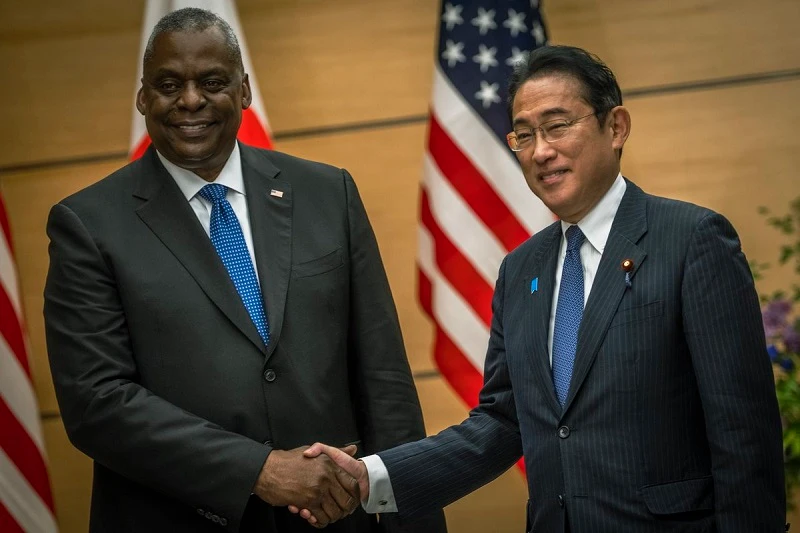

US Defence Secretary Lloyd Austin called on Japanese Prime Minister Fumio Kishida in Tokyo on Thursday (Image courtesy: US Department of Defence)
After signing a new Defence Cooperation Agreement (DCA) with Papua New Guinea (PNG) and strengthening its presence at strategic locations across the Philippines, the United States on Thursday vowed to provide “extended deterrence”, including nuclear capabilities, to Japan which remains worried about China’s growing Pacific presence and North Korea’s increased nuclear and missile activities.
Kicking off his seventh trip to the Indo-Pacific region, which also includes his second visit to India since assuming office, the US Secretary of Defence Lloyd Austin held crucial talks with the defence and foreign ministers of Japan in Tokyo on Thursday.
After the 75-minute meeting, Austin and Japan’s Defence Minister Yasukazu Hamada reconfirmed that they would maintain international order based on rules and a Free and Open Indo-Pacific in this “age of intense competition” and would not accept any unilateral attempt to change the status quo by force in the Indo-Pacific region.
More significantly, they agreed to deepen cooperation and to advance the discussions related to the possibility of the joint development in a future interceptor against counter-hypersonic technology, in addition to cooperation in Unmanned Aerial Vehicles (UAVs).
The announcement came as the US Pacific Air Forces moved the RQ-4 Global Hawks to Japan’s Yokota Air Base from the Andersen Air Force Base in Guam to provide “theatrewide enduring operations” in support of maintaining a free and open Indo-Pacific.
The Global Hawk serves as a high-altitude, long-endurance, remotely piloted and unarmed, aerial reconnaissance system. The aircraft provides persistent, day and night, high-resolution, all-weather imagery of large geographic areas with an array of integrated sensors and cameras.
Besides launching a series of new force postures initiatives with Australia, including increased rotations of US bombers and fighters at Australian bases, the US is also forward deploying its Marine Littoral Regiment – the Marine Corps’ most advanced formation – to Japan by 2025, significantly enhancing combat-credible deterrence.
The US Air Force has already temporarily deployed the MQ-9 Reaper UAVs to the Japan Maritime Self-Defence Force’s Kanoya Air Base. The two forces also jointly operate the US-Japan Bilateral Intelligence Analysis Cell (BIAC) at Yokota Air Base since November 2022 which plays a significant role in strengthening Intelligence, Surveillance, and Reconnaissance (ISR) capabilities.
The “increasingly severe security environment” in the region also came up for discussion during Austin’s meeting with Japanese Foreign Minister Yoshimasa Hayashi.
A Japanese Foreign Ministry statement said later that both sides remain concerned about North Korea and China’s unilateral changes to the status quo, including Wednesday’s launch using ballistic missile technology that it calls “military reconnaissance satellites.”
While the importance of having an “open dialogue” with China was affirmed, Austin termed “unfortunate” Beijing’s decision to cancel Chinese Defence Minister Li Shangfu’s meeting with him at the Shangri-La Dialogue in Singapore this week.
The move comes after the US Indo-Pacific Command on Tuesday accused a Chinese J-16 fighter pilot of performing an “unnecessarily aggressive manoeuvre” during the intercept of a US Air Force RC-135 aircraft in international airspace over the South China Sea, earlier this week.
“The PRC pilot flew directly in front of the nose of the RC-135, forcing the US aircraft to fly through its wake turbulence,” said a statement from USINDOPACOM.
Meanwhile, Austin is slated to go ahead with his mission of strengthening cooperation with “like-minded” countries, including further deepening the US-India Major Defence Partnership which Washington said has entered “a new and exciting” chapter.
This includes not only the launching of the India-US Initiative on Critical and Emerging Technology (iCET) to drive co-development and co-production of major defence platforms but also deepening interoperability and coordination through a string of military exercises.
The upcoming Exercise ‘Talisman Saber’ in Australia (July 22-August 4) will bring together like-minded partners from across the region and around the world, including India, the US, Australia, Canada, France, Germany, Indonesia, Japan, South Korea, New Zealand, and the United Kingdom.
Australia will also be hosting Exercise Malabar for the first time in August this year. The multilateral Quad exercise will bring greater transparency to the region by leveraging cutting-edge commercial satellite technology to provide Indo-Pacific partners with near-real-time data and analysis of maritime activities in their territorial waters.
President Droupadi Murmu addressed the Slovakia-India Business Forum in Bratislava on Thursday and expressed India's…
UK Chancellor Rachel Reeves and Finance Minister Nirmala Sitharaman announced USD 400 million in new…
European Commission President Ursula von der Leyen on Thursday stated that the EU will pause…
Japan has highlighted the growing security threat posed by China, noting Beijing's attempts to unilaterally…
Chiu Chui-cheng, the Minister of the Mainland Affairs Council, advised Taiwanese academicians and students to…
Pakistan has distanced itself from the 2008 Mumbai terror attack accused Tahawwur Rana and said…